IT Write-up: Data Models, DBMS, Relational Data, and Business Rules
VerifiedAdded on 2023/04/23
|8
|2015
|125
Report
AI Summary
This IT write-up delves into fundamental data concepts, including data, fields, records, and files, and explores data redundancy and independence. It examines the role and functions of Database Management Systems (DBMS), highlighting their importance in data storage, transformation, and management. The report further discusses the significance of data models in system development, business rules, and their translation into data model components. It outlines the basic features of relational data models, emphasizing their benefits for end-users and designers, with references to relevant research. The write-up provides a comprehensive overview of these topics, offering insights into their practical applications and importance in the field of data management and information technology.

qwertyuiopasdfghjklzxcvbnmqw
ertyuiopasdfghjklzxcvbnmqwert
yuiopasdfghjklzxcvbnmqwertyui
opasdfghjklzxcvbnmqwertyuiop
asdfghjklzxcvbnmqwertyuiopasd
fghjklzxcvbnmqwertyuiopasdfgh
jklzxcvbnmqwertyuiopasdfghjkl
zxcvbnmqwertyuiopasdfghjklzxc
vbnmqwertyuiopasdfghjklzxcvb
nmqwertyuiopasdfghjklzxcvbnm
qwertyuiopasdfghjklzxcvbnmqw
ertyuiopasdfghjklzxcvbnmqwert
yuiopasdfghjklzxcvbnmqwertyui
opasdfghjklzxcvbnmqwertyuiop
asdfghjklzxcvbnmqwertyuiopasd
fghjklzxcvbnmqwertyuiopasdfgh
jklzxcvbnmrtyuiopasdfghjklzxcv
IT Write-up
1/19/2019
ertyuiopasdfghjklzxcvbnmqwert
yuiopasdfghjklzxcvbnmqwertyui
opasdfghjklzxcvbnmqwertyuiop
asdfghjklzxcvbnmqwertyuiopasd
fghjklzxcvbnmqwertyuiopasdfgh
jklzxcvbnmqwertyuiopasdfghjkl
zxcvbnmqwertyuiopasdfghjklzxc
vbnmqwertyuiopasdfghjklzxcvb
nmqwertyuiopasdfghjklzxcvbnm
qwertyuiopasdfghjklzxcvbnmqw
ertyuiopasdfghjklzxcvbnmqwert
yuiopasdfghjklzxcvbnmqwertyui
opasdfghjklzxcvbnmqwertyuiop
asdfghjklzxcvbnmqwertyuiopasd
fghjklzxcvbnmqwertyuiopasdfgh
jklzxcvbnmrtyuiopasdfghjklzxcv
IT Write-up
1/19/2019
Paraphrase This Document
Need a fresh take? Get an instant paraphrase of this document with our AI Paraphraser
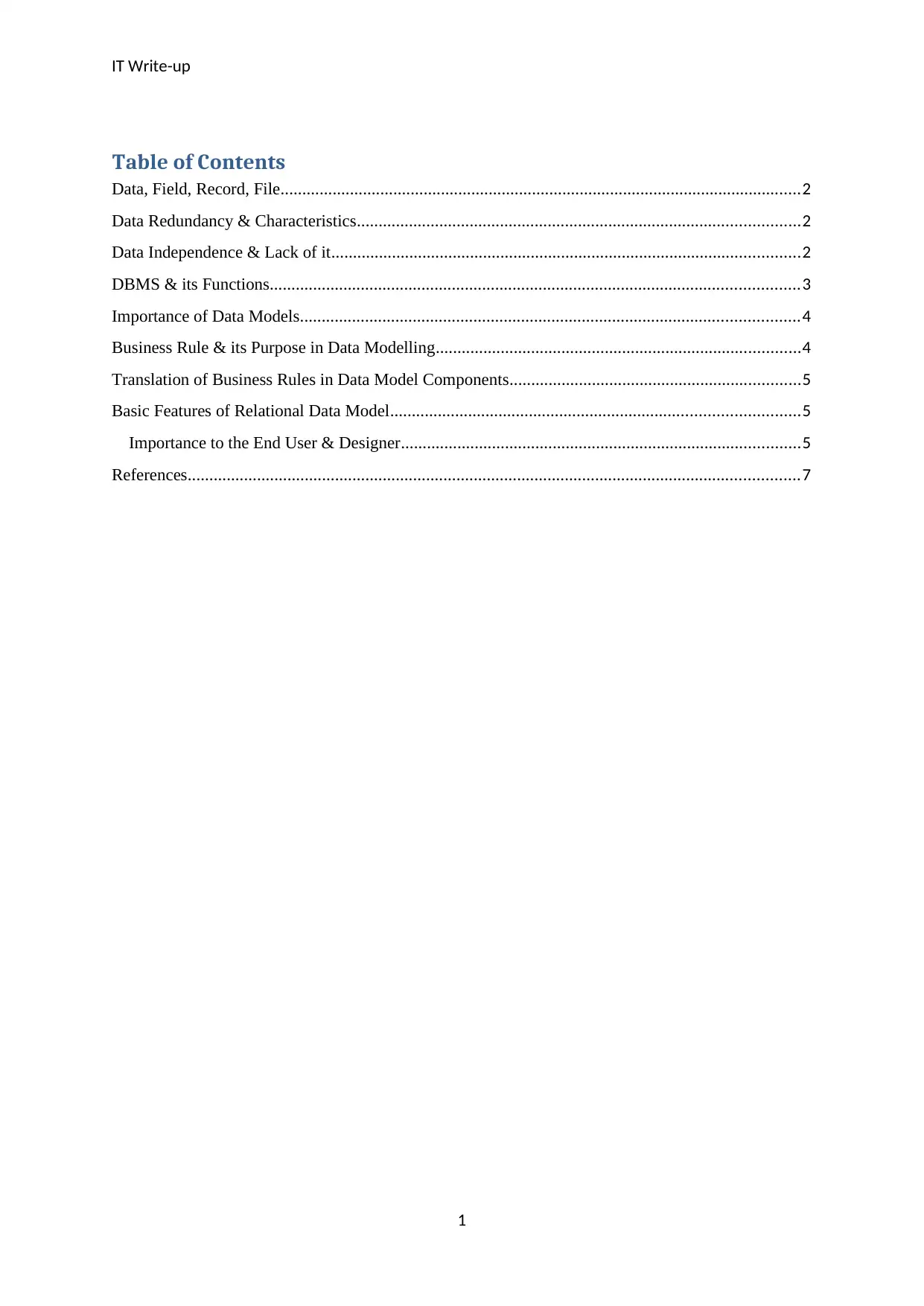
IT Write-up
Table of Contents
Data, Field, Record, File........................................................................................................................2
Data Redundancy & Characteristics......................................................................................................2
Data Independence & Lack of it............................................................................................................2
DBMS & its Functions..........................................................................................................................3
Importance of Data Models...................................................................................................................4
Business Rule & its Purpose in Data Modelling....................................................................................4
Translation of Business Rules in Data Model Components...................................................................5
Basic Features of Relational Data Model..............................................................................................5
Importance to the End User & Designer............................................................................................5
References.............................................................................................................................................7
1
Table of Contents
Data, Field, Record, File........................................................................................................................2
Data Redundancy & Characteristics......................................................................................................2
Data Independence & Lack of it............................................................................................................2
DBMS & its Functions..........................................................................................................................3
Importance of Data Models...................................................................................................................4
Business Rule & its Purpose in Data Modelling....................................................................................4
Translation of Business Rules in Data Model Components...................................................................5
Basic Features of Relational Data Model..............................................................................................5
Importance to the End User & Designer............................................................................................5
References.............................................................................................................................................7
1
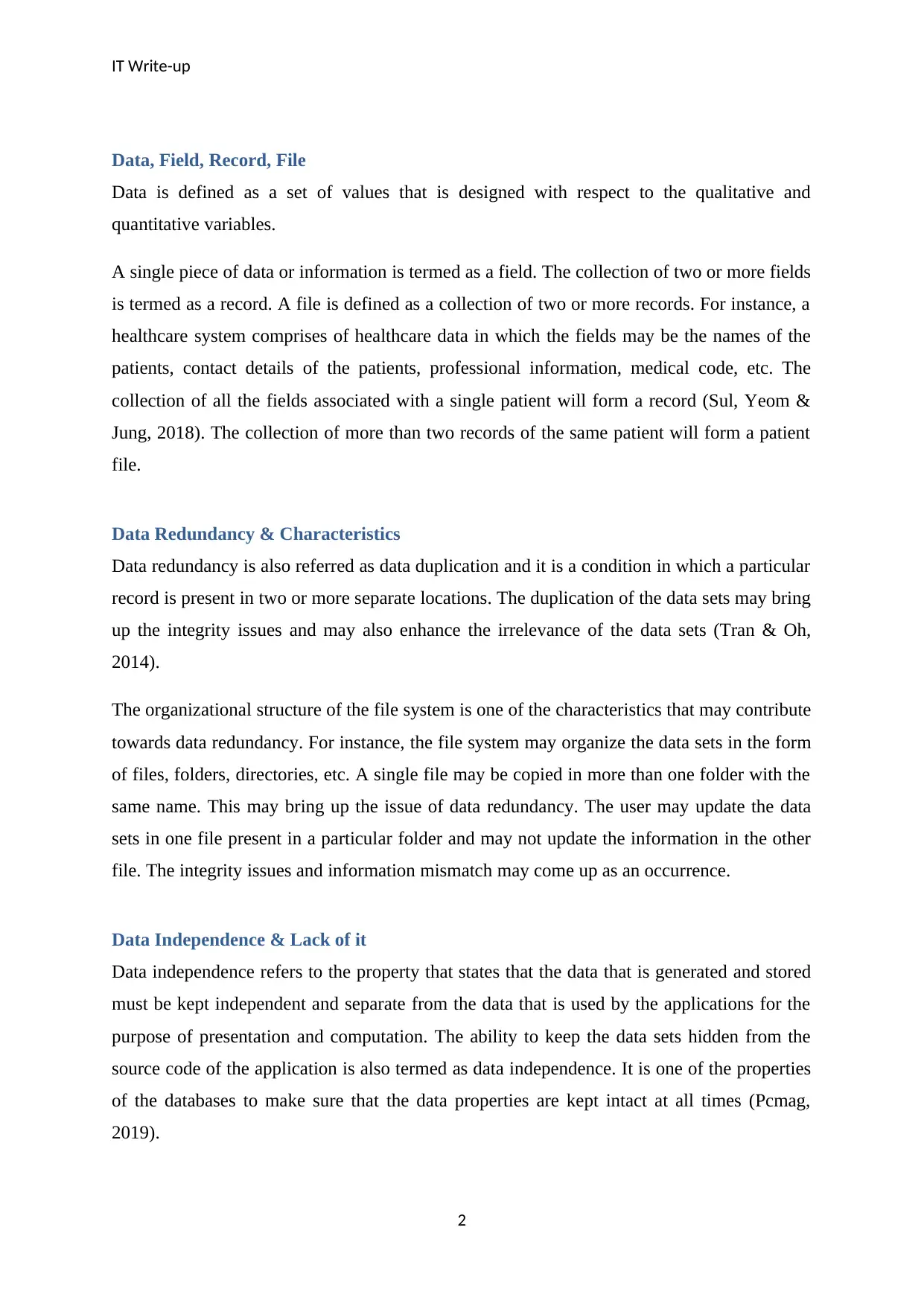
IT Write-up
Data, Field, Record, File
Data is defined as a set of values that is designed with respect to the qualitative and
quantitative variables.
A single piece of data or information is termed as a field. The collection of two or more fields
is termed as a record. A file is defined as a collection of two or more records. For instance, a
healthcare system comprises of healthcare data in which the fields may be the names of the
patients, contact details of the patients, professional information, medical code, etc. The
collection of all the fields associated with a single patient will form a record (Sul, Yeom &
Jung, 2018). The collection of more than two records of the same patient will form a patient
file.
Data Redundancy & Characteristics
Data redundancy is also referred as data duplication and it is a condition in which a particular
record is present in two or more separate locations. The duplication of the data sets may bring
up the integrity issues and may also enhance the irrelevance of the data sets (Tran & Oh,
2014).
The organizational structure of the file system is one of the characteristics that may contribute
towards data redundancy. For instance, the file system may organize the data sets in the form
of files, folders, directories, etc. A single file may be copied in more than one folder with the
same name. This may bring up the issue of data redundancy. The user may update the data
sets in one file present in a particular folder and may not update the information in the other
file. The integrity issues and information mismatch may come up as an occurrence.
Data Independence & Lack of it
Data independence refers to the property that states that the data that is generated and stored
must be kept independent and separate from the data that is used by the applications for the
purpose of presentation and computation. The ability to keep the data sets hidden from the
source code of the application is also termed as data independence. It is one of the properties
of the databases to make sure that the data properties are kept intact at all times (Pcmag,
2019).
2
Data, Field, Record, File
Data is defined as a set of values that is designed with respect to the qualitative and
quantitative variables.
A single piece of data or information is termed as a field. The collection of two or more fields
is termed as a record. A file is defined as a collection of two or more records. For instance, a
healthcare system comprises of healthcare data in which the fields may be the names of the
patients, contact details of the patients, professional information, medical code, etc. The
collection of all the fields associated with a single patient will form a record (Sul, Yeom &
Jung, 2018). The collection of more than two records of the same patient will form a patient
file.
Data Redundancy & Characteristics
Data redundancy is also referred as data duplication and it is a condition in which a particular
record is present in two or more separate locations. The duplication of the data sets may bring
up the integrity issues and may also enhance the irrelevance of the data sets (Tran & Oh,
2014).
The organizational structure of the file system is one of the characteristics that may contribute
towards data redundancy. For instance, the file system may organize the data sets in the form
of files, folders, directories, etc. A single file may be copied in more than one folder with the
same name. This may bring up the issue of data redundancy. The user may update the data
sets in one file present in a particular folder and may not update the information in the other
file. The integrity issues and information mismatch may come up as an occurrence.
Data Independence & Lack of it
Data independence refers to the property that states that the data that is generated and stored
must be kept independent and separate from the data that is used by the applications for the
purpose of presentation and computation. The ability to keep the data sets hidden from the
source code of the application is also termed as data independence. It is one of the properties
of the databases to make sure that the data properties are kept intact at all times (Pcmag,
2019).
2
⊘ This is a preview!⊘
Do you want full access?
Subscribe today to unlock all pages.

Trusted by 1+ million students worldwide
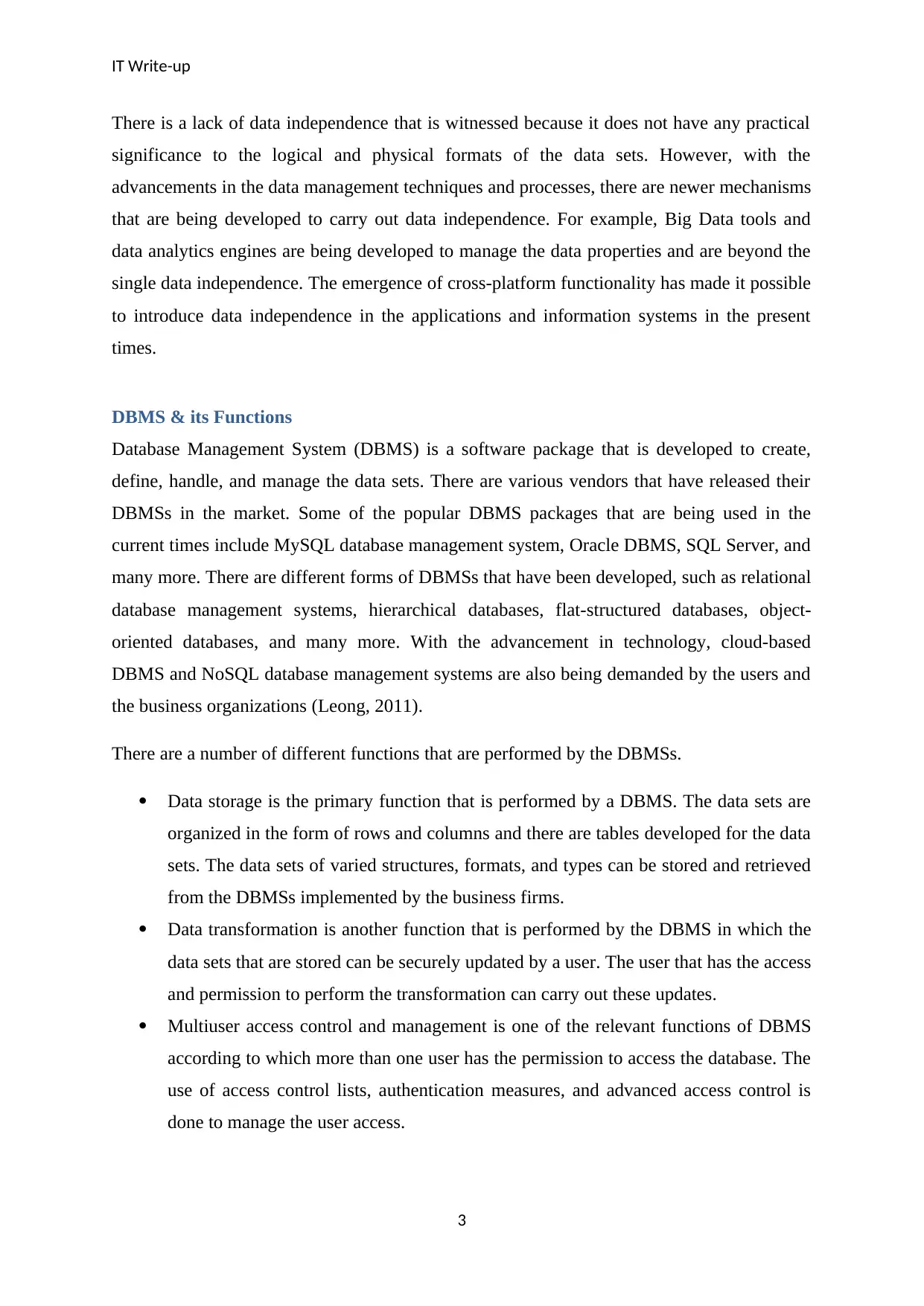
IT Write-up
There is a lack of data independence that is witnessed because it does not have any practical
significance to the logical and physical formats of the data sets. However, with the
advancements in the data management techniques and processes, there are newer mechanisms
that are being developed to carry out data independence. For example, Big Data tools and
data analytics engines are being developed to manage the data properties and are beyond the
single data independence. The emergence of cross-platform functionality has made it possible
to introduce data independence in the applications and information systems in the present
times.
DBMS & its Functions
Database Management System (DBMS) is a software package that is developed to create,
define, handle, and manage the data sets. There are various vendors that have released their
DBMSs in the market. Some of the popular DBMS packages that are being used in the
current times include MySQL database management system, Oracle DBMS, SQL Server, and
many more. There are different forms of DBMSs that have been developed, such as relational
database management systems, hierarchical databases, flat-structured databases, object-
oriented databases, and many more. With the advancement in technology, cloud-based
DBMS and NoSQL database management systems are also being demanded by the users and
the business organizations (Leong, 2011).
There are a number of different functions that are performed by the DBMSs.
Data storage is the primary function that is performed by a DBMS. The data sets are
organized in the form of rows and columns and there are tables developed for the data
sets. The data sets of varied structures, formats, and types can be stored and retrieved
from the DBMSs implemented by the business firms.
Data transformation is another function that is performed by the DBMS in which the
data sets that are stored can be securely updated by a user. The user that has the access
and permission to perform the transformation can carry out these updates.
Multiuser access control and management is one of the relevant functions of DBMS
according to which more than one user has the permission to access the database. The
use of access control lists, authentication measures, and advanced access control is
done to manage the user access.
3
There is a lack of data independence that is witnessed because it does not have any practical
significance to the logical and physical formats of the data sets. However, with the
advancements in the data management techniques and processes, there are newer mechanisms
that are being developed to carry out data independence. For example, Big Data tools and
data analytics engines are being developed to manage the data properties and are beyond the
single data independence. The emergence of cross-platform functionality has made it possible
to introduce data independence in the applications and information systems in the present
times.
DBMS & its Functions
Database Management System (DBMS) is a software package that is developed to create,
define, handle, and manage the data sets. There are various vendors that have released their
DBMSs in the market. Some of the popular DBMS packages that are being used in the
current times include MySQL database management system, Oracle DBMS, SQL Server, and
many more. There are different forms of DBMSs that have been developed, such as relational
database management systems, hierarchical databases, flat-structured databases, object-
oriented databases, and many more. With the advancement in technology, cloud-based
DBMS and NoSQL database management systems are also being demanded by the users and
the business organizations (Leong, 2011).
There are a number of different functions that are performed by the DBMSs.
Data storage is the primary function that is performed by a DBMS. The data sets are
organized in the form of rows and columns and there are tables developed for the data
sets. The data sets of varied structures, formats, and types can be stored and retrieved
from the DBMSs implemented by the business firms.
Data transformation is another function that is performed by the DBMS in which the
data sets that are stored can be securely updated by a user. The user that has the access
and permission to perform the transformation can carry out these updates.
Multiuser access control and management is one of the relevant functions of DBMS
according to which more than one user has the permission to access the database. The
use of access control lists, authentication measures, and advanced access control is
done to manage the user access.
3
Paraphrase This Document
Need a fresh take? Get an instant paraphrase of this document with our AI Paraphraser
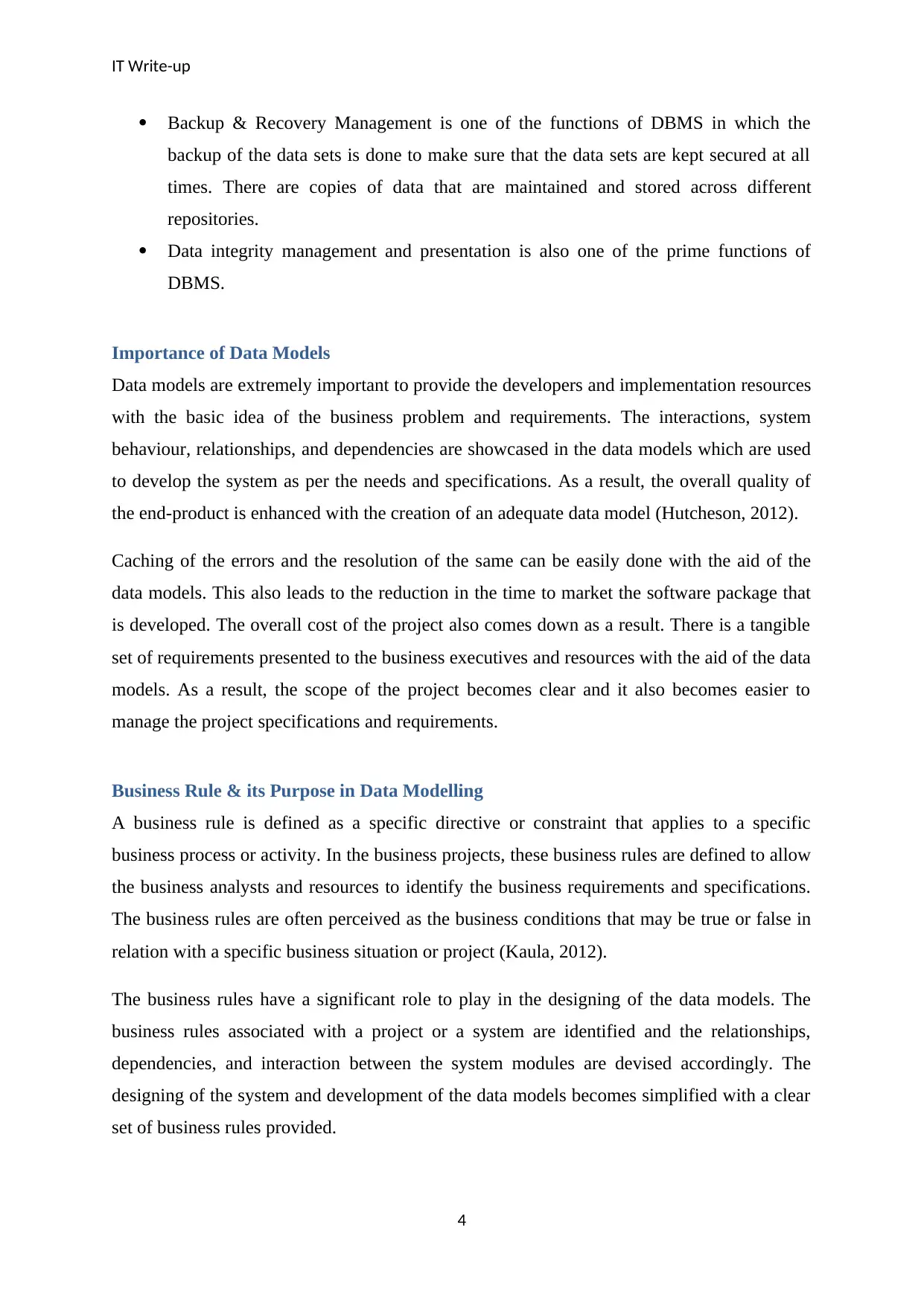
IT Write-up
Backup & Recovery Management is one of the functions of DBMS in which the
backup of the data sets is done to make sure that the data sets are kept secured at all
times. There are copies of data that are maintained and stored across different
repositories.
Data integrity management and presentation is also one of the prime functions of
DBMS.
Importance of Data Models
Data models are extremely important to provide the developers and implementation resources
with the basic idea of the business problem and requirements. The interactions, system
behaviour, relationships, and dependencies are showcased in the data models which are used
to develop the system as per the needs and specifications. As a result, the overall quality of
the end-product is enhanced with the creation of an adequate data model (Hutcheson, 2012).
Caching of the errors and the resolution of the same can be easily done with the aid of the
data models. This also leads to the reduction in the time to market the software package that
is developed. The overall cost of the project also comes down as a result. There is a tangible
set of requirements presented to the business executives and resources with the aid of the data
models. As a result, the scope of the project becomes clear and it also becomes easier to
manage the project specifications and requirements.
Business Rule & its Purpose in Data Modelling
A business rule is defined as a specific directive or constraint that applies to a specific
business process or activity. In the business projects, these business rules are defined to allow
the business analysts and resources to identify the business requirements and specifications.
The business rules are often perceived as the business conditions that may be true or false in
relation with a specific business situation or project (Kaula, 2012).
The business rules have a significant role to play in the designing of the data models. The
business rules associated with a project or a system are identified and the relationships,
dependencies, and interaction between the system modules are devised accordingly. The
designing of the system and development of the data models becomes simplified with a clear
set of business rules provided.
4
Backup & Recovery Management is one of the functions of DBMS in which the
backup of the data sets is done to make sure that the data sets are kept secured at all
times. There are copies of data that are maintained and stored across different
repositories.
Data integrity management and presentation is also one of the prime functions of
DBMS.
Importance of Data Models
Data models are extremely important to provide the developers and implementation resources
with the basic idea of the business problem and requirements. The interactions, system
behaviour, relationships, and dependencies are showcased in the data models which are used
to develop the system as per the needs and specifications. As a result, the overall quality of
the end-product is enhanced with the creation of an adequate data model (Hutcheson, 2012).
Caching of the errors and the resolution of the same can be easily done with the aid of the
data models. This also leads to the reduction in the time to market the software package that
is developed. The overall cost of the project also comes down as a result. There is a tangible
set of requirements presented to the business executives and resources with the aid of the data
models. As a result, the scope of the project becomes clear and it also becomes easier to
manage the project specifications and requirements.
Business Rule & its Purpose in Data Modelling
A business rule is defined as a specific directive or constraint that applies to a specific
business process or activity. In the business projects, these business rules are defined to allow
the business analysts and resources to identify the business requirements and specifications.
The business rules are often perceived as the business conditions that may be true or false in
relation with a specific business situation or project (Kaula, 2012).
The business rules have a significant role to play in the designing of the data models. The
business rules associated with a project or a system are identified and the relationships,
dependencies, and interaction between the system modules are devised accordingly. The
designing of the system and development of the data models becomes simplified with a clear
set of business rules provided.
4
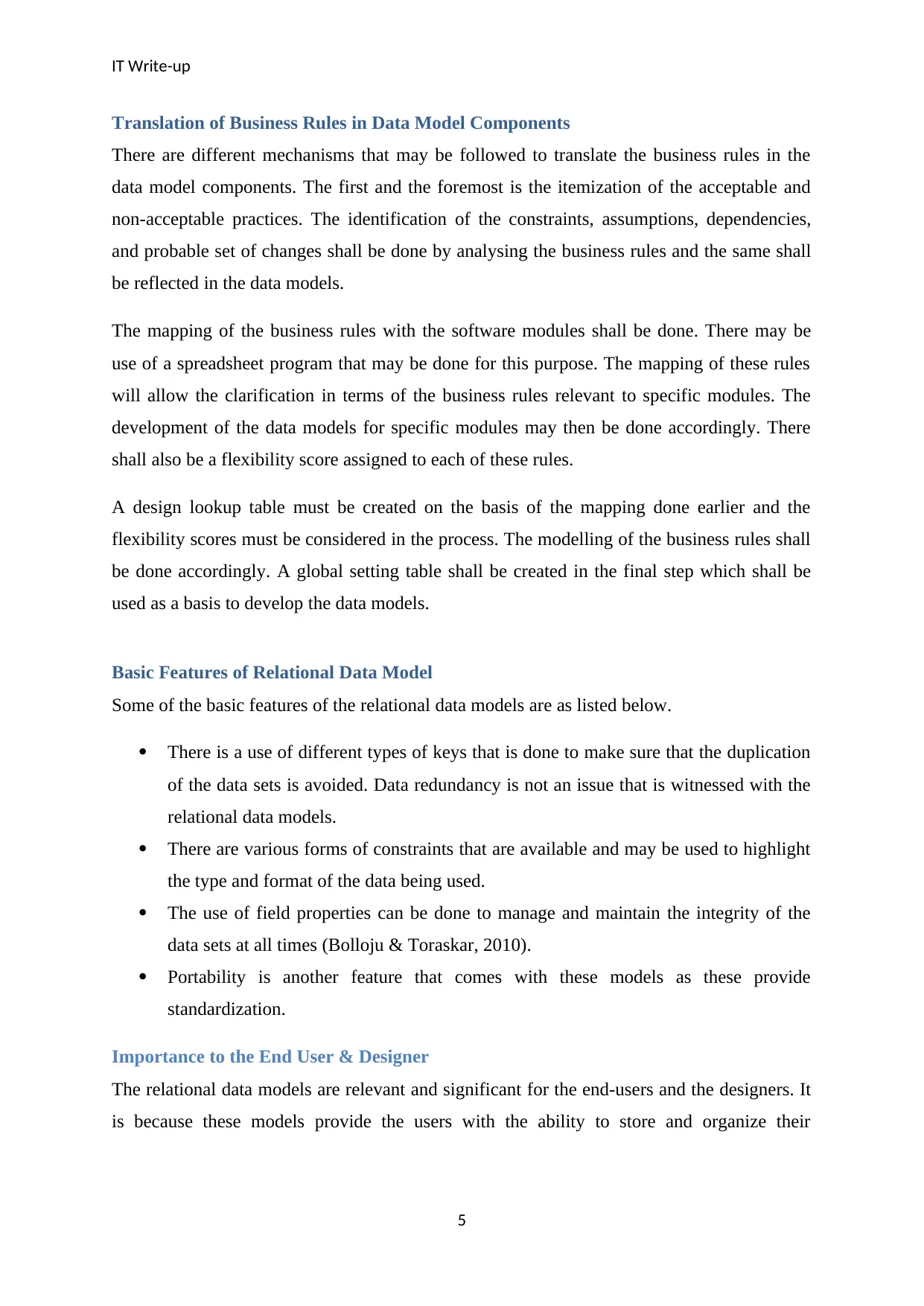
IT Write-up
Translation of Business Rules in Data Model Components
There are different mechanisms that may be followed to translate the business rules in the
data model components. The first and the foremost is the itemization of the acceptable and
non-acceptable practices. The identification of the constraints, assumptions, dependencies,
and probable set of changes shall be done by analysing the business rules and the same shall
be reflected in the data models.
The mapping of the business rules with the software modules shall be done. There may be
use of a spreadsheet program that may be done for this purpose. The mapping of these rules
will allow the clarification in terms of the business rules relevant to specific modules. The
development of the data models for specific modules may then be done accordingly. There
shall also be a flexibility score assigned to each of these rules.
A design lookup table must be created on the basis of the mapping done earlier and the
flexibility scores must be considered in the process. The modelling of the business rules shall
be done accordingly. A global setting table shall be created in the final step which shall be
used as a basis to develop the data models.
Basic Features of Relational Data Model
Some of the basic features of the relational data models are as listed below.
There is a use of different types of keys that is done to make sure that the duplication
of the data sets is avoided. Data redundancy is not an issue that is witnessed with the
relational data models.
There are various forms of constraints that are available and may be used to highlight
the type and format of the data being used.
The use of field properties can be done to manage and maintain the integrity of the
data sets at all times (Bolloju & Toraskar, 2010).
Portability is another feature that comes with these models as these provide
standardization.
Importance to the End User & Designer
The relational data models are relevant and significant for the end-users and the designers. It
is because these models provide the users with the ability to store and organize their
5
Translation of Business Rules in Data Model Components
There are different mechanisms that may be followed to translate the business rules in the
data model components. The first and the foremost is the itemization of the acceptable and
non-acceptable practices. The identification of the constraints, assumptions, dependencies,
and probable set of changes shall be done by analysing the business rules and the same shall
be reflected in the data models.
The mapping of the business rules with the software modules shall be done. There may be
use of a spreadsheet program that may be done for this purpose. The mapping of these rules
will allow the clarification in terms of the business rules relevant to specific modules. The
development of the data models for specific modules may then be done accordingly. There
shall also be a flexibility score assigned to each of these rules.
A design lookup table must be created on the basis of the mapping done earlier and the
flexibility scores must be considered in the process. The modelling of the business rules shall
be done accordingly. A global setting table shall be created in the final step which shall be
used as a basis to develop the data models.
Basic Features of Relational Data Model
Some of the basic features of the relational data models are as listed below.
There is a use of different types of keys that is done to make sure that the duplication
of the data sets is avoided. Data redundancy is not an issue that is witnessed with the
relational data models.
There are various forms of constraints that are available and may be used to highlight
the type and format of the data being used.
The use of field properties can be done to manage and maintain the integrity of the
data sets at all times (Bolloju & Toraskar, 2010).
Portability is another feature that comes with these models as these provide
standardization.
Importance to the End User & Designer
The relational data models are relevant and significant for the end-users and the designers. It
is because these models provide the users with the ability to store and organize their
5
⊘ This is a preview!⊘
Do you want full access?
Subscribe today to unlock all pages.

Trusted by 1+ million students worldwide

IT Write-up
information sets. Also, the data security and privacy is maintained by these models. With the
aid of the portability, the data sets can be easily transferred and shared in a secure manner.
The designers can also benefit from these models as they can get to know about the data
relationships and properties with the aid of the relational data models.
6
information sets. Also, the data security and privacy is maintained by these models. With the
aid of the portability, the data sets can be easily transferred and shared in a secure manner.
The designers can also benefit from these models as they can get to know about the data
relationships and properties with the aid of the relational data models.
6
Paraphrase This Document
Need a fresh take? Get an instant paraphrase of this document with our AI Paraphraser
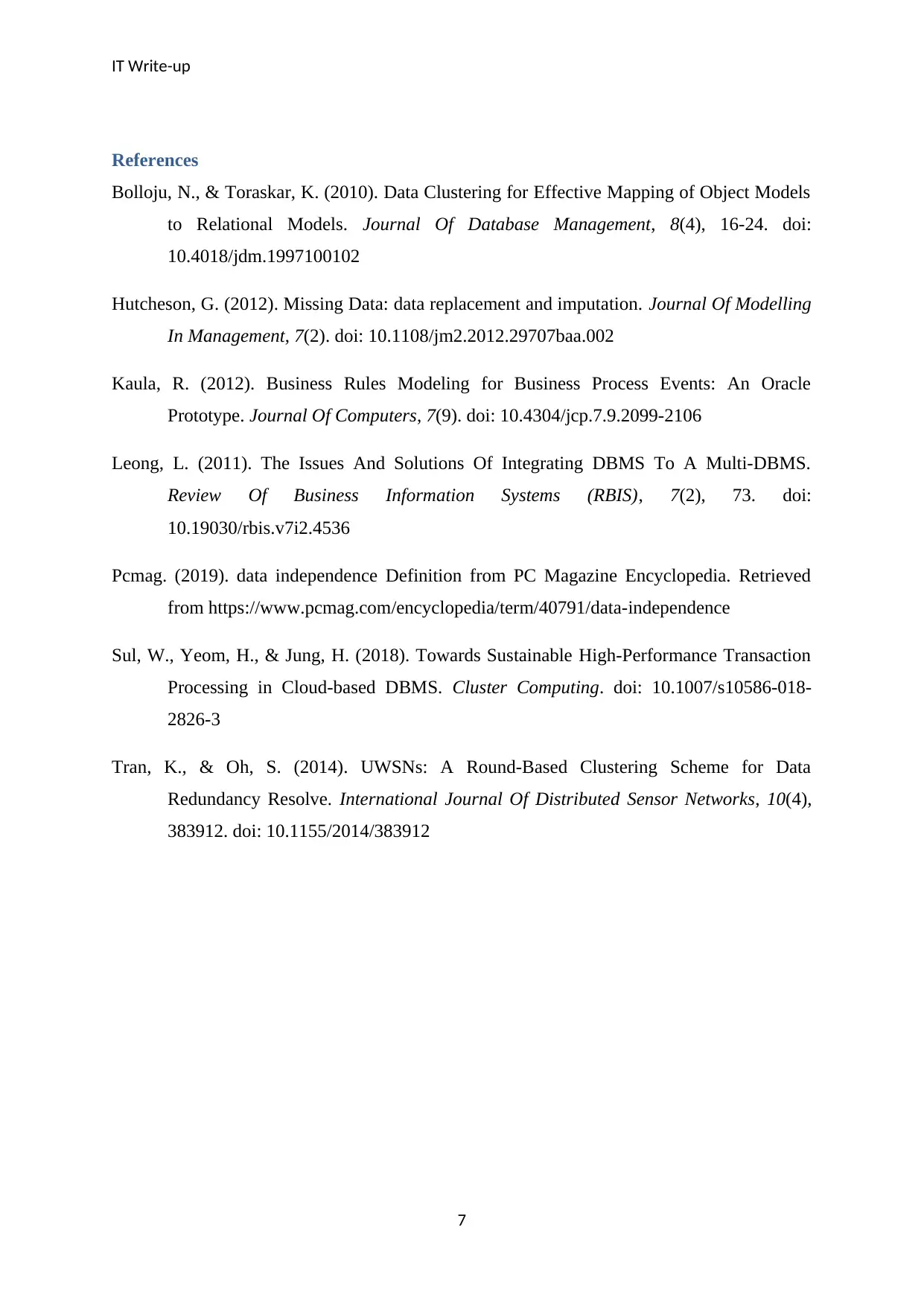
IT Write-up
References
Bolloju, N., & Toraskar, K. (2010). Data Clustering for Effective Mapping of Object Models
to Relational Models. Journal Of Database Management, 8(4), 16-24. doi:
10.4018/jdm.1997100102
Hutcheson, G. (2012). Missing Data: data replacement and imputation. Journal Of Modelling
In Management, 7(2). doi: 10.1108/jm2.2012.29707baa.002
Kaula, R. (2012). Business Rules Modeling for Business Process Events: An Oracle
Prototype. Journal Of Computers, 7(9). doi: 10.4304/jcp.7.9.2099-2106
Leong, L. (2011). The Issues And Solutions Of Integrating DBMS To A Multi-DBMS.
Review Of Business Information Systems (RBIS), 7(2), 73. doi:
10.19030/rbis.v7i2.4536
Pcmag. (2019). data independence Definition from PC Magazine Encyclopedia. Retrieved
from https://www.pcmag.com/encyclopedia/term/40791/data-independence
Sul, W., Yeom, H., & Jung, H. (2018). Towards Sustainable High-Performance Transaction
Processing in Cloud-based DBMS. Cluster Computing. doi: 10.1007/s10586-018-
2826-3
Tran, K., & Oh, S. (2014). UWSNs: A Round-Based Clustering Scheme for Data
Redundancy Resolve. International Journal Of Distributed Sensor Networks, 10(4),
383912. doi: 10.1155/2014/383912
7
References
Bolloju, N., & Toraskar, K. (2010). Data Clustering for Effective Mapping of Object Models
to Relational Models. Journal Of Database Management, 8(4), 16-24. doi:
10.4018/jdm.1997100102
Hutcheson, G. (2012). Missing Data: data replacement and imputation. Journal Of Modelling
In Management, 7(2). doi: 10.1108/jm2.2012.29707baa.002
Kaula, R. (2012). Business Rules Modeling for Business Process Events: An Oracle
Prototype. Journal Of Computers, 7(9). doi: 10.4304/jcp.7.9.2099-2106
Leong, L. (2011). The Issues And Solutions Of Integrating DBMS To A Multi-DBMS.
Review Of Business Information Systems (RBIS), 7(2), 73. doi:
10.19030/rbis.v7i2.4536
Pcmag. (2019). data independence Definition from PC Magazine Encyclopedia. Retrieved
from https://www.pcmag.com/encyclopedia/term/40791/data-independence
Sul, W., Yeom, H., & Jung, H. (2018). Towards Sustainable High-Performance Transaction
Processing in Cloud-based DBMS. Cluster Computing. doi: 10.1007/s10586-018-
2826-3
Tran, K., & Oh, S. (2014). UWSNs: A Round-Based Clustering Scheme for Data
Redundancy Resolve. International Journal Of Distributed Sensor Networks, 10(4),
383912. doi: 10.1155/2014/383912
7
1 out of 8
Your All-in-One AI-Powered Toolkit for Academic Success.
+13062052269
info@desklib.com
Available 24*7 on WhatsApp / Email
![[object Object]](/_next/static/media/star-bottom.7253800d.svg)
Unlock your academic potential
Copyright © 2020–2025 A2Z Services. All Rights Reserved. Developed and managed by ZUCOL.


